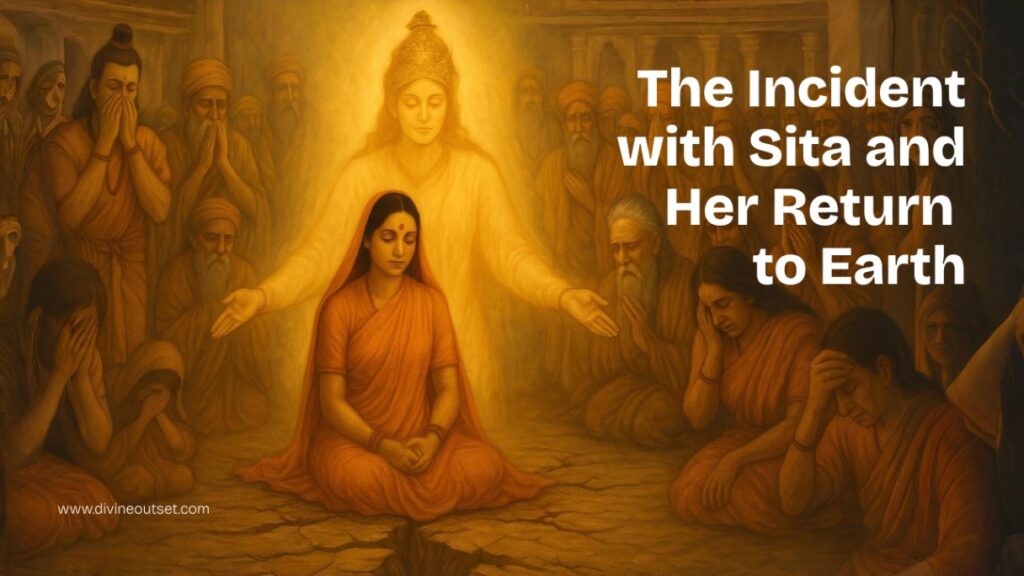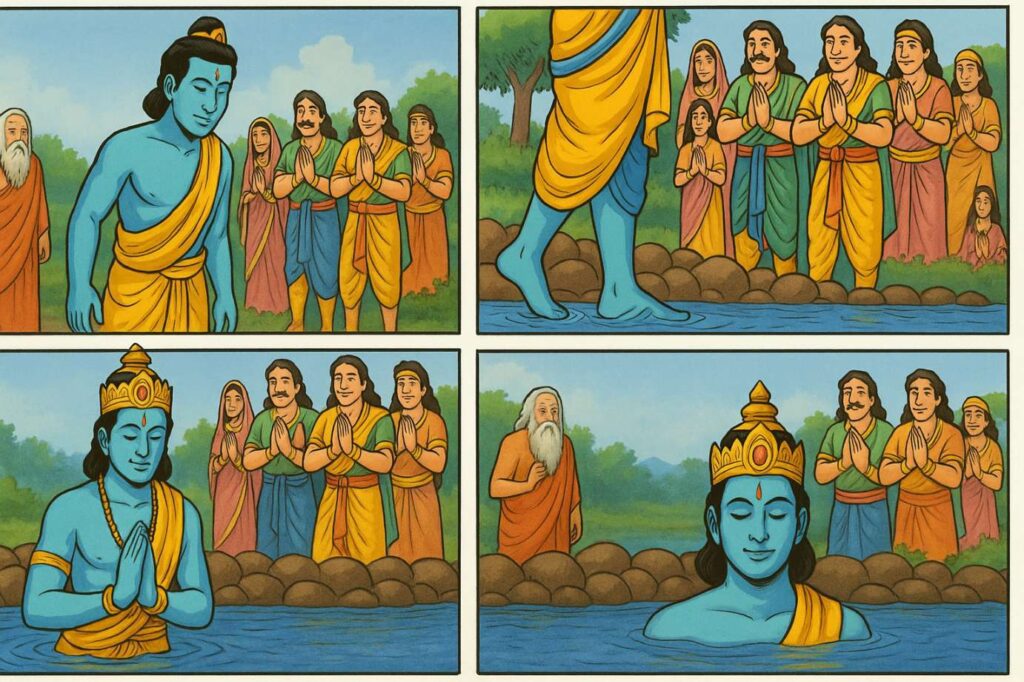How Lord Ram Died – Hidden Secret of Rama Death
Shri Ram’s departure from the worldly realm is one of the most profound and spiritual episodes in Hindu history. In this blog, we will be delving into the symbolic closure of the earthly and celestial adventures of Lord Ram and how lord Ram died.
Read the Whole Blog ‘How Lord Rama Died’ In the 60s:
Return to Ayodhya and Rule of Dharma
Shri Ram, after defeating Ravana, returned to Ayodhya with Sita, Lakshman and others accompanying him. He is known for his love and fairness, and most importantly stuck to his dharma.
However, soon the society questioned Sita’s purity and even after her fire test (Agni Pariksha) it became a dilemma. Ram, duty-bound as a king and to avoid social doubt, sentenced Sita to the forest. This decision affected him deeply, as both a man and as a king, sad but duty comes first.
This will serve as a prelude to the events of the story, where personal loss represents the potential ultimate price of leadership. This is the start of the pain, why and how lord Ram died.
The Incident with Sita and Her Return to Earth

Sita, while in exile, took refuge in Sage Valmiki’s ashram and gave birth to Luv and Kush.
Ram invited Sita back to Ayodhya, requested her to prove her purity one more time., After the many tests that she endured, she prayed to Mother Earth, who opened up and accepted her back.
This marked her final departure, and Ram accepted it, knowing that he would never forget her. This makes the reason stronger for how lord Ram died.
The Curse of Sage Durvasa and the Role of Lakshman
Sage Durvasa visited Shri Ram one day, bringing news from the gods that could not wait. Ram was in a private meeting and had directed Lakshman not to allow anyone to disturb him.
Durvasa threatened to curse the whole of Ayodhya if he was not allowed in. Lakshman made the noble decision to interrupt Ram’s meeting with Lakshman to protect Ayodhya.
Ram had no choice but to leave Lakshman to face the consequences of this noble act because the commitment he made as a king was that breaking such a vow would require disciplinary action.
Ram ultimately made the decision to exile Lakshman. Following Dharma, Lakshman accepted the exile and walked to the River Sarayu where he transitioned using yogic means.
This transition was significant, as he was Sheshnag and thus Lakshman’s departure from the Earth meant Ram too would not be on Earth for long.
Shri Ram’s Departure (Not Died) to the Sarayu River

Upon the death of Lakshman, Shri Ram understood that he had finished his earthly purpose as well. He called the inhabitants of Ayodhya, handed on his duties to Luv and Kush, and walked down to the banks of the Sarayu river. In a yogic state he allowed himself to sink into the waters and depart from his earthly body. Finally, he merged back into his original divine form, Lord Vishnu.
This is pactically considered death, though not death in the conventional sense. When God’s incarnations finish their elemental experiences, it can be construed as a divine return.
In this case, the end of Ram’s earthly time would meld into a forever experience in Vaikuntha. The occasion was warmly celebrated with spiritual reflection and ceremonious gratitude.
Source: How Did Ram Die
Beliefs Around Ram’s Return as Kalki
Many scriptures and forms of spirituality indicate that Ram may return as Kalki, the tenth avatar of Vishnu., to the world in the future. Kalki is believed to come at the end of Kali Yuga (The Age of Darkness) to restore dharma and cosmic order.
This provides believers with the conviction that while dharma never ends, it merely gets reshaped.
Even though Ram has left in his physical form from the Earth, his values and life’s mission remain on the planet.
Many devotees retain the belief that when there is a gross imbalance, as we seem to have now, Vishnu arrives in various forms in order to restore dharma.
The belief that Vishnu incarnates in forms and avatars solidifies believers yet maintains the connection of Ram’s narrative to hope in the unknown future.
What We Learn from Shri Ram’s Final Journey
The life of Shri Ram was one filled with sacrifice, discipline, and truth. The death of Shri Ram teaches us about detachment, duty
and divine discipline. He mechanically remained calm and composed in grief, guided by dharma, whether it was the ordering of Sita into exile, the parting with Lakshman, or the knowledge of detachment that led to the higher purpose of life.
His passing into the Sarayu was not an act of grief, but an act of completion. Shri Ram’s final footprints are etched in our hearts and inspire us to have the courage to travel the path of dharma and righteousness, despite it being difficult. It is what makes him more than a king of Ayodhya, but the eternal light for millions.
To Learn More About Shri Ram, Read Shrimad Bhagwatam Chato 9
How Lord Ram Died – FAQs
What was the reason behind Shri Ram’s death?
Shri Ram's departure was destined after the demise of Lakshman (who was the incarnation of Sheshnag). With his earthly mission finished and the cosmic cycle satisfied, he made the choice to end his avatar and move into Vaikuntha.
What was the age of Ram when he died?
According to Hindu texts and story, Shri Ram was about 11,039 years old when he left the Earth. This is not measured in relation to years – or human years - which is only important as recognition of his long and divine reign when the kingdom of "Ram Rajya" (the kingdom of Ram) was of peace, prosperity and dharma. The number can be compared to a mythological clock – which can denote sometimes great lengths of time, as often referenced in ancient writings, as valid within a context of spiritual greatness and timelessness.
When did Ram die?
The specific historical date of Shri Ram's leaving is not recorded in contemporary calendars, obviously. But a few scholars, astrologers and experts suggested that Shri Ram left the earth in what is termed 'Treta Yuga' (the third cycle), a period from Hindu cosmology, a period of time long before recorded history, when we have another repeated pattern that humans are familiar with. A common theme in Hinduism is to not demean the value of their great avatars by attempting to pinpoint them on a calendar; one significant insight would be - he was "mythically" recorded as returning - into the Sarayu River – at his divine leave from the earth; we remember the spiritual significance, not note and time in the scientific sense.
Did Shri Ram really die or return to Vaikuntha or Saketdhaam?
It is said in Hinduism, Shri Ram would never die, Shri Ram would return to his original living form, that is to say, Lord Vishnu! When Shri Ram left the earth he would be returning to his divine form - when humans see his departing, this would not be deemed as death.
What happened after Shri Ram death?
After the passing of Shri Ram, his sons, Luv and Kush, became the vanguards of his legacy, however, Ram Rajya came to an end and it is believed through spiritual traditions he will return as Kalki the last incarnation of Vishnu in the future.
Where did Shri Ram die?
Shri Ram walked into the Sarayu River near Ayodhya and by doing so he left the illusions of his body on Earth. For many devotees, this location is considered a holy location to leave their mortal bodies.
Is there a temple where Shri Ram died?
Yes, there are several holy pilgrimage sites located along the banks of the Sarayu River in Ayodhya, which contain connections to Shri Ram's final moments. These locations are visited by millions of devotees each year.
Did Lord Ram commit suicide by entering the river?
It is not accurate to say Lord Ram committed suicide. His walking into the Sarayu River signified an act of yoga migration in a divine yoga in a final act, returning period after fulfilling his purpose on Earth. Suicide connotes despair, while Ram returned in fulfillment of his duty to the earth.


One Comment